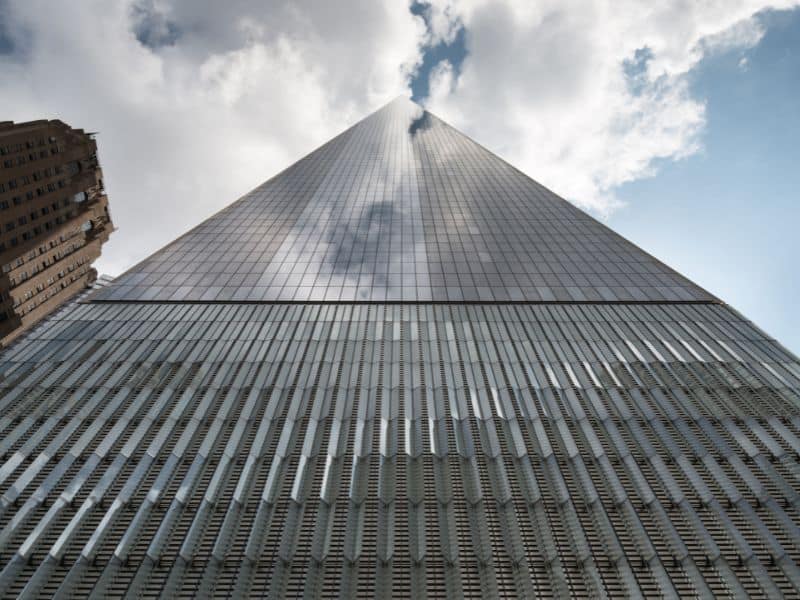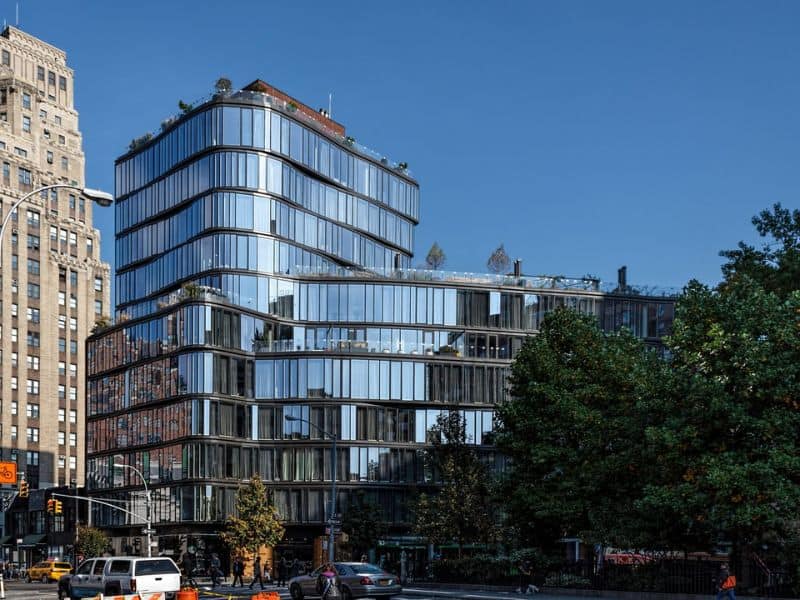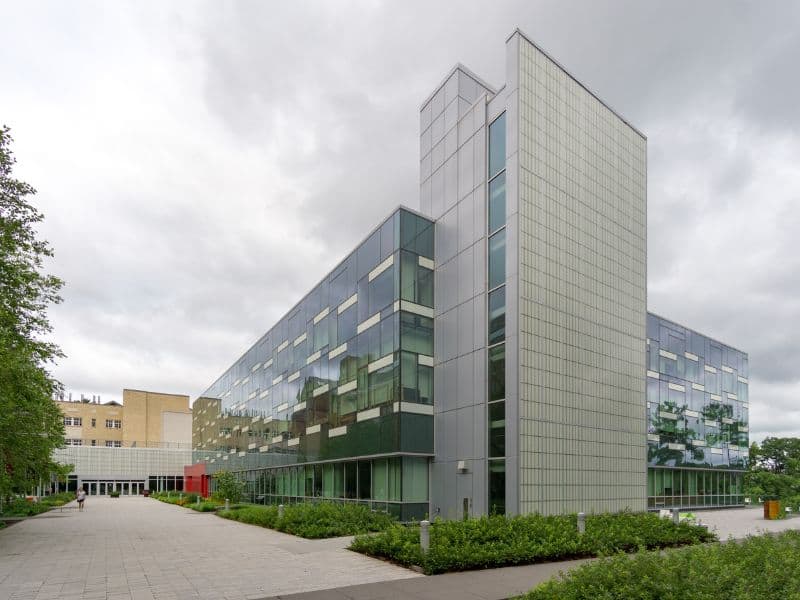The Top 15 Eco-Friendly Sustainable Buildings in New York

Images by Eric Kilby – Flickr: Bank of America Tower Top, CC BY-SA 2.0, Link; Giorgio Galeotti – Own work, CC BY 4.0, Link; Epicgenius – Own work, CC BY-SA 4.0, Link; and Kidfly182 – Own work, CC BY-SA 4.0, Link.
New York, a bustling metropolis renowned for its towering skyscrapers, has emerged as an unexpected champion in the realm of sustainable architecture.
The city hosts an impressive array of eco-friendly structures that are reshaping urban landscapes while prioritizing environmental responsibility.
This article unveils the top 15 sustainable buildings in New York, showcasing how innovative design, efficient energy use, and environmentally friendly materials can come together to create architectural masterpieces.
Dive in and explore where environmental sustainability meets architectural brilliance.
The Top 15 Eco-Friendly Sustainable Buildings in New York
The following is a compiled list of the 15 best sustainable buildings in New York:
- Bank of America Tower
- One World Trade Center
- Hearst Tower (Manhattan)
- 4 Times Square
- The Solaire
- The Visionaire
- The Helena
- Chrysler Building
- The New York Times Building
- Empire State Building
- One Jackson Square
- Benton Hall
- Tilley Lofts
- Human Ecology Building
- Schermerhorn House
1. Bank of America Tower

Building Type: Commercial Offices
Location: Manhattan, New York City
The Bank of America Tower sets a remarkable example of sustainable architecture with an array of outstanding green features:
- LEED Platinum Certification: The building boasts the prestigious LEED Platinum certification, the highest grade for green architecture. This building served as a pioneer in obtaining this certification for commercial skyscrapers.
- Energy Efficiency: Even though implementing energy-efficient features increased construction costs by approximately 6.5 percent, they are projected to save an impressive $3 million annually in energy expenses. Moreover, it’s also expected to enhance productivity by an additional $7 million annually.
- Building-Integrated Photovoltaics (BIPVs): The Bank of America Tower utilizes BIPVs. These are installed above the main entrance and on some eastern facade spandrels.
- Double-Glazed Wall: A double-glazed wall deflects sunlight during the summer. This helps to maintain a cooler internal temperature and reduces the need for air conditioning.
- UV Ray Deflection: The curtain wall design allows 73% of visible light to permeate the building but successfully deflects all harmful ultraviolet rays.
2. One World Trade Center

Building Type: Commercial Offices
Location: Manhattan, New York City
One World Trade Center, an iconic New York landmark, embodies sustainability just as much as it does resilience. A bevy of green features makes this tower a pioneer in eco-friendly construction:
- Recycled Materials: The building’s structure and interiors include recycled materials like gypsum boards and ceiling tiles. The tower recycles about 80% of its waste, showcasing its commitment to waste reduction.
- Rainwater Collection: The design incorporates a smart rainwater collection and recycling scheme. The collected rainwater is utilized to cool the building’s systems, reducing the need for additional water sources.
- Fuel Cell System: One of the largest installations in the world, the tower’s PureCell phosphoric acid fuel cells generate a substantial 4.8 megawatts of power. Additionally, the waste steam from these cells is harnessed to generate electricity.
- Renewable Energy: The structure is not solely reliant on its fuel cells for power. It also uses off-site hydroelectric and wind power, reducing its carbon emission footprint.
- Energy-Efficient Lighting: The building has clear glass windows that maximize sunlight. This reduces the need for artificial lighting. It also uses automatic dimmers for interior lighting to save electricity on sunny days.
3. Hearst Tower (Manhattan)

Building Type: Commercial Offices
Location: Midtown Manhattan, New York
The Hearst Tower proudly showcases green building practices in Midtown Manhattan. Its sustainable design meets rigorous LEED standards. For example, Polyethylene tubes in the limestone-clad floor slabs regulate temperature and humidity. Then, there’s a 14,000-gallon tank that collects rainwater for the captivating Icefall in the lobby.
The tower also boasts a sophisticated daylight dimming system on two executive floors that adjusts to sunlight. Other office floors feature daylight switching systems that automatically turn off when flooded with sunlight.
Approximately 85% of the old building’s internal materials were recycled during construction, showcasing a strong commitment to sustainability. Hearst Tower thus became New York City’s first green building to achieve LEED Gold certification. This was later upgraded to Platinum in 2012.
4. 4 Times Square

Building Type: Commercial Offices
Location: Midtown Manhattan, New York City
4 Times Square, or the Conde Nast Building, is a trailblazer in sustainable high-rise construction. Completed in 1999, it gained global acclaim for its eco-friendly features and technologies, showcasing a strong commitment to sustainability.
- It integrates innovative Building Integrated Photovoltaics (BIPVs) and 400 KW fuel cells as green energy solutions.
- The building has an impressive 85% particulate filtering system, ensuring a healthy indoor environment. CO2 and VOC monitoring mechanisms further enhance the air quality.
- Fly ash was used in the concrete during construction, promoting resource efficiency.
- The mechanical equipment room is strategically located at the top. This allows the natural light to illuminate the engineering team’s workspace.
In summary, 4 Times Square stands as a monument to forward-thinking, environmentally conscious design, setting a benchmark for future green buildings.
5. The Solaire

Building Type: Residential Tower
Location: Manhattan, New York
The Solaire, a residential tower in Manhattan, stands out as a model of green living. Aligning with stringent environmental norms, it surpasses New York’s current guidelines by 35%.
- Its west façade boasts 3,400 square feet of photovoltaics, contributing to 5% of its energy needs. Helpful during summers, this system significantly reduces peak-hour electricity consumption.
- The building’s insulation is a testament to meticulous planning, improving efficiency by limiting air infiltration. Its energy-efficient selection ranges from lights and appliances to acoustic tiles and window treatments.
- The lobby employs daylight sensors that adapt light levels based on natural light changes. Motion sensors control lighting in public corridors and stairwells. While master switches in apartments encourage energy-saving habits.
- The Solaire also focuses on health-conscious living. Therefore, it uses interior paints and surface materials free from off-gassing chemicals.
6. The Visionaire

Building Type: Condominium Complex
Location: Battery Park, New York
The Visionaire, a LEED Platinum-certified condominium complex in Battery Park, New York, is a remarkable testament to eco-friendly architecture and design. This sustainable building boasts a range of impressive features, including:
- Green Rooftop: A rooftop garden with native plants adds vibrancy to the building. These plants provide insulation, reduce heating usage, and manage rainwater. The garden stores excess water, up to 10,000 gallons, intelligently repurposed for sidewalk cleaning and irrigation.
- Curtain wall Technology: The innovative combination of low-emissivity glass and a terracotta rain screen acts as a thermal break. This ensures efficient cooling and heating throughout the building.
- Air Quality: To guarantee a consistently healthy environment, each room benefits from the fresh, filtered air circulation provided by an energy-efficient four-pipe fan-coil system.
- Water Conservation: The Visionaire prioritizes water conservation with its advanced blackwater treatment system. This innovative technology efficiently recycles toilet water, minimizing waste and setting a new standard for responsible water management.
7. The Helena

Building Type: Apartment Building
Location: Manhattan, New York
The Helena is a pioneer in sustainable residential architecture in New York. It has many eco-friendly features. A noteworthy aspect of this system is its sophisticated blackwater recycling technology. This tech can help recover up to 43,000 gallons of wastewater daily, a testament to its responsible water management approach.
The materials used in the building are sustainable, with a focus on recycled, renewable, and locally sourced resources. It’s also energy-efficient, with solar panels and EnergyStar-rated appliances, reducing its carbon footprint. The building has thermopane windows with a special coating that improves thermal efficiency.
Interestingly, the building uses wind power to generate at least 50% of its energy needs, showing its forward-thinking design. Waste heat is also reused to heat water, making it more resource-efficient. Lastly, the building uses cogeneration micro-turbines to power the mechanical equipment and lighting, showcasing innovative green energy solutions.
8. Chrysler Building

Building Type: Corporate Structure
Location: Lexington Avenue, New York
The Chrysler Building is an iconic corporate structure on Lexington Avenue in New York. With its LEED Gold certification, this achievement showcases Tishman Speyer Properties’ environmental commitment. Some of their green highlights are:
- An extensive two-year renovation reduced the building’s resource consumption. Energy usage declined by 21% due to building energy system upgrades.
- An impressive 64% curtailed water consumption by introducing new plumbing fixtures.
- A waste-management policy was implemented, recycling 81% of the building’s waste.
- The entire overhaul was completed at a cost lower than $20 million.
The Chrysler Building’s eco-friendly transformation thus sets an inspiring example for future green building initiatives.
9. The New York Times Building

Building Type: Corporate Structure
Location: Manhattan, New York
The New York Times Building, a prominent corporate structure in Manhattan, represents a remarkable paradigm of sustainable design. With a profound commitment to environmental responsibility, the building showcases substantial electricity and heating energy consumption reductions, surpassing similar structures.
A standout feature of this eco-friendly building is its intelligent lighting system, boasting over 18,000 dimmable fixtures. Each fixture’s electrical ballast houses a sophisticated computer chip that intuitively adjusts to natural light levels and office occupancy, optimizing energy usage.
Moreover, the building has automated shades that adapt based on the sun’s position, glare, and interior heat gain. This thoughtful addition significantly minimizes energy consumption and solar heat. These enhancements truly showcase the building’s green innovation, prioritizing environmental consciousness and occupant comfort.
While the Times Building deliberately avoided the additional costs associated with LEED certification, its design remains a compelling testament to sustainable building practices that can be achieved without compromising cost-effectiveness.
10. Empire State Building

Building Type: Corporate Structure
Location: Midtown Manhattan, New York
The Empire State Building is an iconic Midtown Manhattan, New York corporate structure. It combines green innovation and historical significance. After a $550 million renovation in 2009, the building became a shining example of sustainable design and energy efficiency.
A vital element of this transformation was introducing a film-coated “superwindow.” This window effectively traps heat while allowing natural light to filter through. This ingenious solution significantly reduced air conditioning expenses, resulting in immediate cost savings of $17 million, especially on hot days.
Further exemplifying its commitment to sustainability, the Empire State Building achieved the prestigious LEED Gold certification in 2011. This accolade was earned through substantial energy reductions and the purchase of significant carbon offsets.
Their commitment to sustainability also shines through in their meticulous attention to small operational details. This includes the incorporation of:
- Water-saving bathroom fixtures.
- The use of eco-friendly cleaning supplies; and
- The implementation of recycled paper products.
The Empire State Building is thus a cultural landmark and a beacon of sustainable architectural innovation.
11. One Jackson Square

Building Type: Residential Condominium
Location: Manhattan, New York
One Jackson Square exemplifies mindful living and green innovation, making it a standout in its area. Being one of the first LEED-certified structures in the locale, this building showcases its unwavering commitment to environmental sustainability. Its design and construction prioritize energy efficiency and indoor air quality, aligning with eco-friendly principles.
A notable feature of One Jackson Square is its extensive green roofs, which cover over 20% of the site area. These roofs enhance the building’s visual appeal and increase energy efficiency. They also establish a harmonious connection between the public realm of Jackson Square Park and the private realm of the building, reinforcing its bond with the natural environment.
Moreover, the building utilizes high-performance glazing to provide ample daylight and regulate temperatures. Water harvesting is another essential sustainable feature, ensuring efficient resource utilization.
These green initiatives have earned One Jackson Square a prestigious LEED Silver Certification, solidifying its position as a leader in sustainable residential design.
12. Benton Hall

Building Type: University Center
Location: Hamilton, New York
Benton Hall, a university center in Hamilton, New York, is a prime example of sustainable construction. These are the reasons why it’s included in this list:
- About three-quarters of the waste produced was recycled or salvaged during construction, showcasing a solid commitment to reducing environmental impact.
- Additionally, locally sourced stone within a 500-mile radius was used, minimizing the carbon footprint.
- The building’s design incorporates passive housing principles, resulting in a nearly 50% reduction in energy consumption compared to traditional designs.
- The building’s envelope design and energy systems prioritize reduced consumption rates and visitor comfort.
- Benton Hall also focuses on sustainable site development, stormwater management, regional materials, and indoor air quality.
Benton Hall’s success in achieving its green objectives is evident in its LEED certification scoring. The building aimed for 80 out of 110 points and achieved all, which is a testament to its impressive environmental stewardship.
13. Tilley Lofts

Building Type: Residential Apartment
Location: Watervliet, New York
Tilley Lofts is distinguished by its successful combination of green energy and sustainable building techniques. This remarkable development has achieved LEED Platinum status while ensuring affordability with reasonable rental rates.
Here are some of the outstanding green features of Tilley Lofts:
- A Combined Heat & Power Unit. This is a system that generates electricity on-site and helps to replace electricity that would otherwise be drawn from the electric distribution grid.
- The waste heat from the Combined Heat & Power system is ingeniously used to generate more electricity, provide all domestic hot water, and supplement the geothermal system.
- The geothermal system functions as the building’s primary heating and cooling system.
- Well-insulated walls and ceilings and low air infiltration construction details efficiently minimize the heating and cooling loads while enhancing comfort.
- The use of CFL or LED for all lighting reduces energy usage.
- All appliances are Energy Star rated, ensuring they meet specific efficiency requirements.
These impressive features reduce the environmental impact and enhance the residents’ comfort and living quality.
14. Human Ecology Building

Building Type: University Department
Location: Ithaca, New York
The LEED Platinum-certified Human Ecology Building in Ithaca, New York, shows Cornell University’s dedication to sustainability and environmental preservation. This building is a stunning example of sustainable design and construction, with every detail considered to promote sustainability.
Sustainable wood makes up 91% of the structure. With the majority being certified by the Forest Stewardship Council. Additionally, 24% of the materials used were sourced locally, reducing the carbon footprint associated with transportation.
Indoor air quality was also a priority, with low-emission carpeting and furniture used throughout.
The building encourages low-emitting vehicles by providing preferred parking and an electric vehicle charging station. The glass facade maximizes natural light, reducing the need for artificial lighting and creating a productive environment for occupants.
15. Schermerhorn House

Building Type: Residential Building
Location: Brooklyn, New York
The Schermerhorn House in Brooklyn, New York, is another impressive example of green architecture. Some of its significant sustainable features include:
- Use of Recycled Materials: The building’s primary façade comprises translucent channel glass towers. A significant portion is made from post-consumer waste glass. This approach emphasizes the reuse of materials, reducing waste and environmental impact.
- Energy Efficiency: The façade’s Low-E glazing enhances the building’s thermal performance, thus reducing the need for artificial heating and cooling and ultimately lowering energy consumption.
- Green Roof Terrace: The green roof terrace minimizes the heat island effect on the second floor. This feature contributes to a more stable internal temperature, reducing the need for additional heating or cooling.
- Natural Daylighting: The panelized glass and aluminum façade design allows for maximum daylight penetration, reducing the need for artificial lighting and contributing to energy efficiency.
Through these innovative features, Schermerhorn House manifests its commitment to sustainability and environmental responsibility.
Final Thoughts
This article showcased various examples highlighting the rise of green building design and sustainable construction practices in New York.
Whether it’s residential complexes or university centers, these projects demonstrate the significance of sustainability and environmental stewardship in our modern world.
New York stands at the forefront of this movement, serving as a beacon of inspiration for other cities to follow.
With unwavering support and dedication from governmental bodies, private organizations, and individuals alike, we hope that the adoption of green building practices will continue to expand not only in New York but also beyond its borders.







